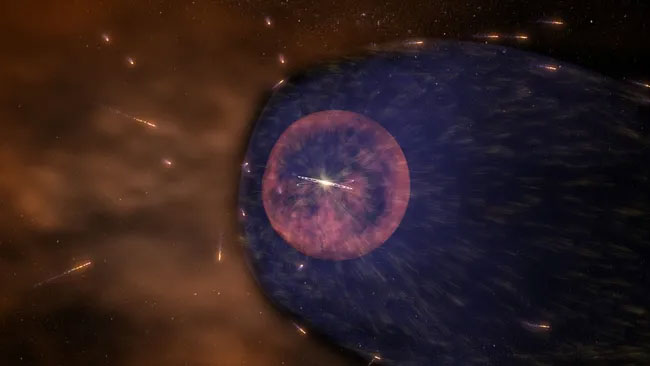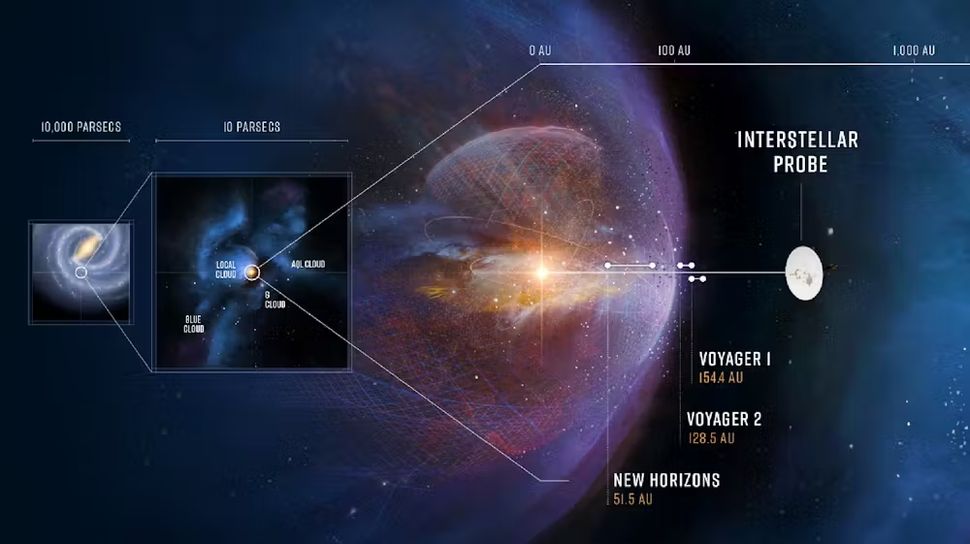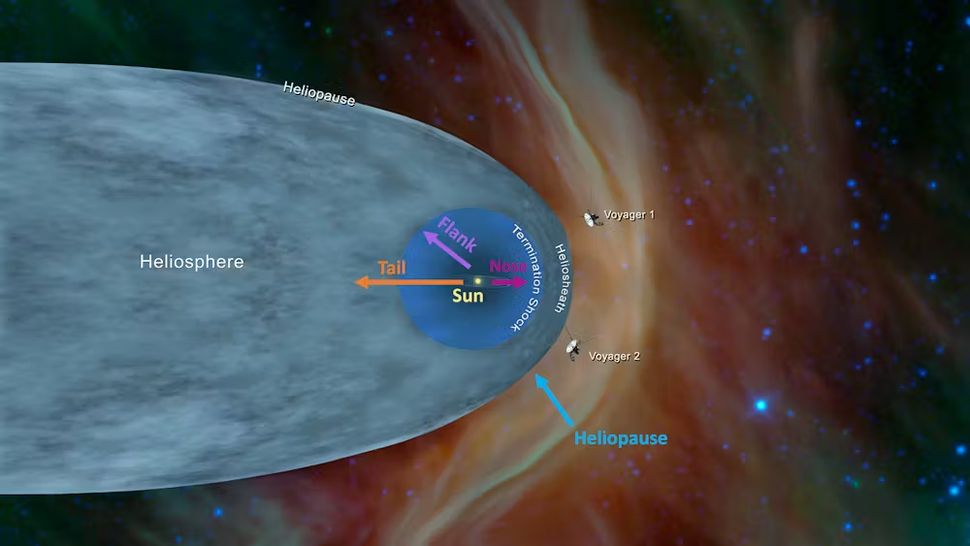Scientists call the region of space that the Sun influences the heliosphere, but without an interstellar probe, they know little about its shape. The heliosphere, the region of space that the Sun influences, is more than a hundred times the distance from the Sun to Earth.
The sun is a star that constantly emits a steady stream of plasma, a highly energetic ionized gas called the solar wind. In addition to the constant solar wind, the sun also occasionally emits eruptions of plasma called coronal mass ejections, which can contribute to the aurora borealis and bursts of light and energy called flares.
Plasma emanating from the sun expands into space along with the sun’s magnetic field. Together, they form the heliosphere within the surrounding local interstellar medium—the plasma, neutral particles, and dust that fill the space between stars and their respective astrospheres.

The heliosphere blocks many cosmic rays, shown as bright streaks in this animated image, from reaching the planets of our solar system. NASA’s Goddard Space Flight Center/Conceptual Image Lab
The eight known planets in the solar system, the asteroid belt between Mars and Jupiter, and the Kuiper belt—a band of celestial objects beyond Neptune that includes the planetoid Pluto—all reside in the heliosphere. The heliosphere is so large that objects in the Kuiper belt orbit closer to the Sun than to the heliosphere’s closest boundary.
When distant stars explode, they release huge amounts of radiation into interstellar space in the form of high-energy particles known as cosmic rays. These cosmic rays can be dangerous to living organisms and can damage electronic devices and spacecraft.
The Earth’s atmosphere protects life on the planet from the effects of cosmic radiation, but even before that, the heliosphere itself acts as a cosmic shield against most interstellar radiation.

An artist’s impression of the heliosphere and its place in the local interstellar medium and the Milky Way galaxy. The interstellar probe could travel farther than any previous spacecraft and give scientists a good look at our heliosphere — the Sun’s influence in space — from the outside. JHU/APL
In addition to cosmic radiation, neutral particles and dust are constantly entering the heliosphere from the local interstellar medium. These particles can affect the space around the Earth and can even change how the solar wind reaches the Earth.
Supernovae and the interstellar medium may also have influenced the origin of life and the evolution of humans on Earth. Some researchers predict that millions of years ago, the heliosphere came into contact with a cold, dense cloud of particles in the interstellar medium, which caused the heliosphere to contract, exposing the Earth to the local interstellar medium.
But scientists don’t actually know what shape the heliosphere is. Models range in shape from spherical to comet-like to croissant-shaped. These projections vary in size by hundreds or thousands of times the distance from the sun to Earth.
However, scientists have defined the direction in which the sun moves as the “nose” direction, and the opposite direction as the “tail” direction. The nose direction should have the shortest distance to the heliopause – the boundary between the heliosphere and the local interstellar medium.
No probe has ever gotten a good view of the heliosphere from the outside or properly sampled the local interstellar medium. This could tell scientists more about the shape of the heliosphere and its interactions with the local interstellar medium, the space environment beyond the heliosphere.

An artist’s impression of the heliosphere—its true shape remains unknown. Labels for the sun, heliopause, and nose and tail directions are included, along with an example of a flank direction. The Voyager probes are thought to have crossed the boundary of the heliosphere during their multi-year journey. NASA/JPL-Caltech
In 1977, NASA launched the Voyager mission, sending two spacecraft flying past Jupiter, Saturn, Uranus, and Neptune in the outer solar system. Scientists determined that after observing these gas giants, the probes individually crossed the heliopause and entered interstellar space in 2012 and 2018, respectively.
Although Voyager 1 and 2 are the only probes that have ever potentially crossed the heliopause, they have long since exceeded their intended mission lifespans. They may no longer be able to return the data they need as their instruments slowly fail or shut down. These spacecraft were designed to study planets, not the interstellar medium. This means they do not have the necessary instruments to make all the measurements of the interstellar medium or heliosphere that scientists need.
That’s where a potential interstellar probe mission could come in. A probe designed to fly beyond the heliopause would help scientists study the heliosphere from the outside.
Because the heliosphere is so large, it would take decades for a probe to reach its edge, even using a gravity assist from a massive planet like Jupiter.
NASA is considering developing an interstellar probe. This probe would measure plasma and magnetic fields in the interstellar medium and image the heliosphere from the outside. To prepare, NASA has solicited input from more than 1,000 scientists on the mission concept.
The original report recommended that the probe follow a trajectory that is about 45 degrees off the heliosphere’s nose. This trajectory would follow part of Voyager’s path while reaching some new areas of space. This way, scientists could study new areas and revisit some partially known areas of space.
This path will give the probe only a partial angular image of the heliosphere, and it will not be able to see the heliotail, the region about which scientists know the least.
Scientists predict that in the heliotail, the plasma that makes up the heliosphere mixes with the plasma that makes up the interstellar medium. This occurs through a process called magnetic reconnection, which allows charged particles to rush from the local interstellar medium into the heliosphere. Just like neutral particles entering through the nose, these particles affect the cosmic environment within the heliosphere.
However, in this case, the particles are charged and can interact with solar and planetary magnetic fields. Although these interactions occur at the edges of the heliosphere, very far from Earth, they affect the composition of the inner heliosphere.
A trajectory that crosses the flank of the heliosphere toward the tail will give scientists a unique opportunity to study an entirely new region of space within the heliosphere. As the probe exits the heliosphere into interstellar space, it will have an outside view of the heliosphere from an angle that will give scientists a more detailed picture of its shape, especially in the contested tail region. Ultimately, no matter which direction the interstellar probe is launched, the scientific data it returns will be invaluable and literally astronomical.




